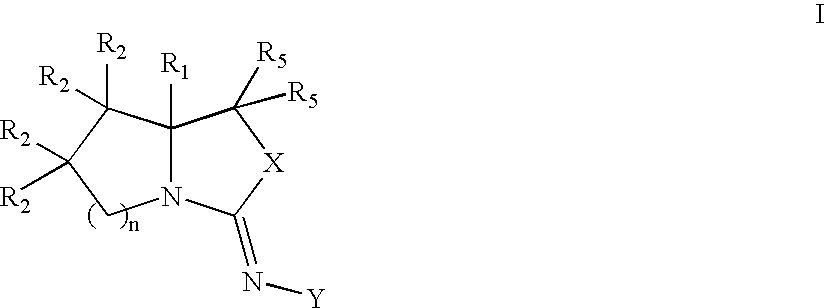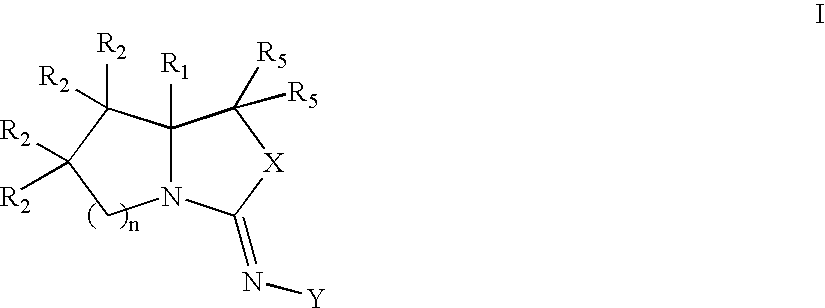Bicyclic modulators of androgen receptor function
a technology of androgen receptors and bicyclic compounds, applied in the field of bicyclic compounds, can solve the problems of adverse effects on male sexual function, liver damage, prostate cancer, etc., and achieve the effect of reducing the number of side effects of androgen administration, reducing the effectiveness of known androgen modulators, and improving the effect of androgen receptor function
- Summary
- Abstract
- Description
- Claims
- Application Information
AI Technical Summary
Problems solved by technology
Method used
Image
Examples
example 1
[0187] Z-4-[(7R,7aR)-7-(hydroxy)-tetrahydro-pyrrolo[1,2-c]oxazol-3-ylideneamino]-2-chloro-3-methyl-benzonitrile
1A. (2S,3S)-3-Hydroxy-2-pyrrolidinecarboxylic Acid Methyl Ester Hydrochloride Salt
[0188]
[0189] Hydrogen chloride gas was bubbled through a suspension of trans-3-hydroxy-L-proline (50.0 g, 0.380 mol) in MeOH (600 mL) cooled to 0° C. for 10 min. The resulting clear solution was stirred at rt for 4 h, then concentrated carefully under reduced pressure (white precipitates formed during the concentration). The resulting white solid was dried under vacuum overnight to afford the title compound (68.3 g) as a white solid.
1B. (2S,3S)-N-tert-Butyloxycarbonyl-3-hydroxy-2-pyrrolidinecarboxylic Acid Methyl Ester
[0190]
[0191] To a suspension of compound 1A (68.3 g, 0.375 mol) in CH2Cl2 (1.00 L) cooled to 0° C. was added Et3N (105 mL, 0.755 mol), followed by portionwise addition of di-tert-butyl dicarbonate (83.0 g, 0.380 mol). The resulting mixture was stirred at rt for 4 h, then par...
example 2
Z-4-[(7S,7aR)-7-(hydroxy)-tetrahydro-pyrrolo[1,2-c]oxazol-3-ylideneamino]-2-chloro-3-methyl-benzonitrile
[0207]
2A. (2S,3S)-3-hydroxy-2-carboxylic Acid Methyl ester-2-pyrrolidine-1-carboxylic Acid (3-chloro-4-cyano-2-methyl-phenyl)-amide
[0208]
[0209] To a solution of 3-hydroxy-pyrrolidine-2-carboxylic acid methyl ester hydrochloride salt (1A) (915 mg, 5.03 mmol.) in CH2Cl2 (20 mL) was added diisopropylethyl amine (1.83 mL, 10.5 mmol), followed by 2-chloro-4-isocyanato-3-methyl-benzonitrile (1G) (806 mg, 4.2 mmol) and the mixture was stirred overnight. After filtering and concentrating, the resulting residue was purified via flash chromatography (silica gel, 0-50% EtOAc in hexane) to provide compound 2A (1.20 g). LCMS: m / z 338 [M+H]+.
2B. (2S,3S)-3-(tert-butyldimethylsilanoxy)-2-carboxylic acid methyl ester-2-pyrrolidine-1-carboxylic acid (3-chloro-4-cyano-2-methyl-phenyl)-amide
[0210] To a solution of compound 2A (862 mg, 2.55 mmol) in CH2Cl2 (8 mL) was added DMF (4 mL), imidazole ...
example 3
Z-4-[(7S,7aS)-7-(hydroxy)-7a-methyl-tetrahydro-pyrrolo[1,2-c]oxazol-3-ylideneamino]-2-chloro-3-methyl-benzonitrile
[0215]
3A. (2R,3S)-3-Hydroxy-2-methylpyrrolidine-1,2-dicarboxylic Acid 1-tert-butyl Ester 2-methyl Ester
[0216]
[0217] To diisopropylamine (4.88 mL, 34.8 mmol) in THF (33 mL) at −78° C. was added a 1.37 M solution of n-butyllithium in hexane (24.6 mL, 33.7 mmol). After stirring at the same temperature for 40 min, the LDA solution was transferred via cannula over 30 min to a solution of compound 1B (2.75 g, 11.2 mmol) in THF (112 mL) at −78° C. The reaction was stirred for 1.5 h when iodomethane (10.5 mL, 168 mmol) was added and the reaction was stirred at −78° C. for 2 h then was stored at −40° C. overnight. After warming to rt and stirring overnight, the reaction was quenched with saturated aqueous ammonium chloride. Ethyl acetate was added and the layers were separated. The organic layer was washed with brine, and the aqueous layer was back-extracted with EtOAc. The com...
PUM
| Property | Measurement | Unit |
|---|---|---|
| weight | aaaaa | aaaaa |
| weight | aaaaa | aaaaa |
| weight | aaaaa | aaaaa |
Abstract
Description
Claims
Application Information
 Login to View More
Login to View More - R&D
- Intellectual Property
- Life Sciences
- Materials
- Tech Scout
- Unparalleled Data Quality
- Higher Quality Content
- 60% Fewer Hallucinations
Browse by: Latest US Patents, China's latest patents, Technical Efficacy Thesaurus, Application Domain, Technology Topic, Popular Technical Reports.
© 2025 PatSnap. All rights reserved.Legal|Privacy policy|Modern Slavery Act Transparency Statement|Sitemap|About US| Contact US: help@patsnap.com



